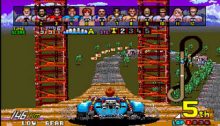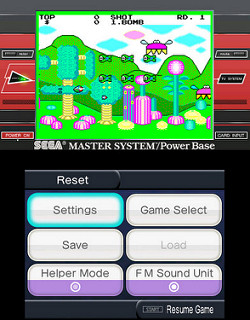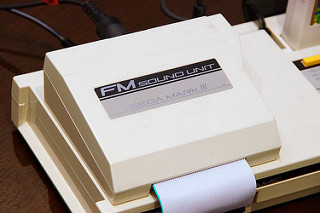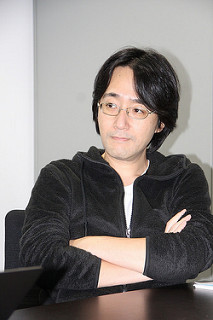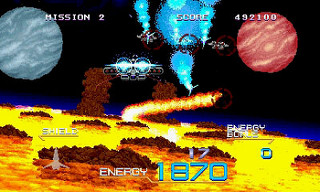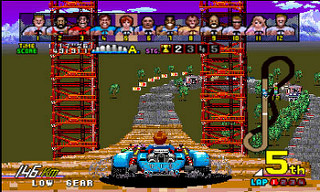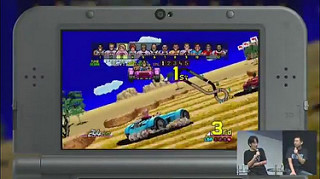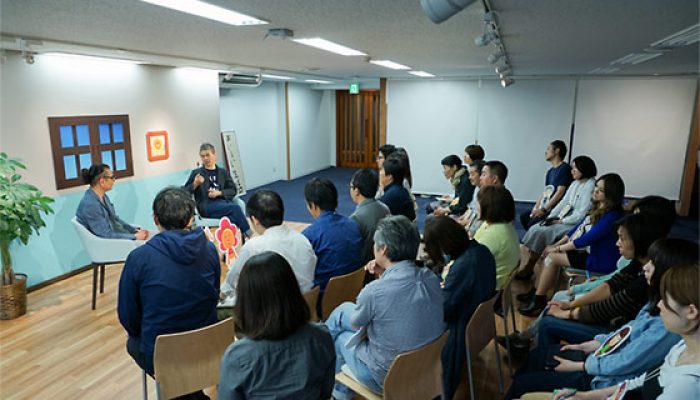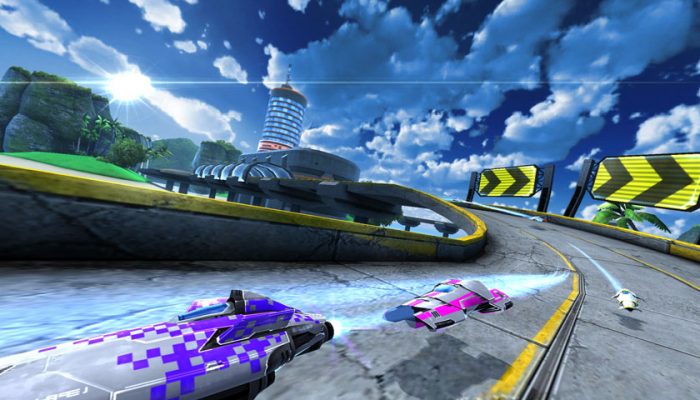 In memory of Akira Saito.
In memory of Akira Saito.
☆ NintendObs Weekly – Monday, April 25, 2016 – Sunday, May 1, 2016.
Monday Apr 25, 2016
With the SEGA 3D Classics Collection now released into North America, we wanted to provide the fans with what has become a long standing tradition: A translation of Game Watch Impress’s interviews of SEGA and M2, which outline some of the ins and outs of porting these titles to Nintendo 3DS, and their lasting legacy as true arcade classics that defined not just a generation of gamers, but the echos of which can be felt in the works of modern-age developers and programmers. The interviews are as lengthly as they are insightful so we’ll be releasing them in slightly abridged and arranged installments, the first of which is below. For the originals, click here to view Part 1 and Part 2.
But while there’s plenty of information here to delve over, you will notice the name Akira Saito in the interviews from time to time. Unfortunately, Mr. Saito died earlier this year after a battle with cancer at the young age of 43. With his incredible prowess in audio programming and his genius and inquisitive devotion to getting decades-old hardware precisely emulated on modern-day handhelds, all of the 3D Classics are truly elevated thanks to his efforts. As a company, we are both forever grateful to his amazing contributions to the project, and immensely saddened by his death. So our request to you is this: Even if it’s for just a moment, take a second while playing the 3D Classics and remember the hard work that Mr. Saito and all his colleagues at M2 contribute to the game. It would mean a lot to him.
With that, here are the localized versions of the interviews:
What’s with this FM Sound Unit toggle button for the SEGA Mark III Version of ‘Fantasy Zone’ !?
A FM Sound Unit option can be seen for the Mark III ‘Fantasy Zone’, even though FM shouldn’t be supported…
Yosuke Okunari (Below YO): Well, I’m sure Horii-san is bursting to talk about it, so let’s just get started about the biggest bonus feature for Fantasy Zone, the FM Sound Unit!
When I played this a little while ago, I was surprised that there was a ‘FM Sound Unit’ option for the Mark III version of Fantasy Zone… This is hasn’t been a thing up until now, right?
YO: You are correct! The Mark III version of Fantasy Zone was released in 1986, but the FM Sound Unit wasn’t released until the fall of 1987. So, game titles that were released before the FM Sound Unit shouldn’t support it. The actual Mark III version of Fantasy Zone doesn’t, naturally.
….However, for the SEGA 3D Classics Collection, this Mark III version of Fantasy Zone does.
That sentence makes me think “What in the world are these people talking about?” I suppose that’s always the case. (laughs)
Naoki Horii (Below NH): We have a story behind this as well. When we decided to put the MK3 version of Fantasy Zone in as a bonus, there was this one guy at the office who said, “Only adding stereoscopic 3D? Pfft, boring!” Seriously, that’s what I deal with here! As I’ve said before, even just that takes a ton of time, but then they say that’s boring… You gotta wonder what the guys are thinking! (laughs)
The FM synthesis version of the Fantasy Zone music was actually used in a different game called Fantasy Zone: The Maze*. So, we lightly discussed with (Manabu) Namiki, who is in charge of the sound, if we could bring the music from that. But Namiki said “Wait just a minute!”
He interjected by saying “The music for Fantasy Zone and Fantasy Zone: The Maze has a different tempo, and even if we brought it over, there’s no way we could turn that into a palatable dish for people.” He also mentioned the songs for the boss battles didn’t exist as well.
*Fantasy Zone: The Maze is a dot-eating genre game released at the end of 1987. It’s known as Opa-Opa in Japan.
….But for some reason, we ended up thinking about how nice it would be to have a FM Sound version. I’m not exactly sure how we ended up there. (laughs)
(laughs)
NH: One of the people working with Namiki on the sound was (Tatsuhiko) Kasuga. He also DJs chip-tune music under the name ‘Tappy’, so people may know him from that.
YO: He’s a new weapon at M2.
NH: He is. One day, he was handed a textbook on the Z80* by Namiki who just told him “Read this. Read, and be enlightened.” (laughs) Once he did, he brought out the audio driver for Fantasy Zone II, and succeeded in replacing the data and playing sounds. Through that, he learned enough to supplement the songs that are available from Fantasy Zone: The Maze… But Namiki said, “Those tunes won’t cut it!”
*Zilog Z80: A very prolific 8-bit processor that was very common in the late 70s and 80s.
So we switched out one song, but before we knew it, somehow all the songs were completed. Kasuga said, “We’re placing the notes within the range of the Mark III Fantasy Zone II audio driver, but there’s a lot of bugs typical of an early-age driver so we’ll fix the bugs and then program it into this one (Fantasy Zone). “ Within 2 or 3 months, most of the songs were finished.
YO: I would play the new ROM at the office when they cut us one, so when I saw this “FM Sound Unit” option on the Fantasy Zone menu, I actually wrote in a bug report that said, “This game doesn’t support the FM Sound Unit, so please remove this option.” But it never seemed to go away. (laughs)
NH: We continued working on it without telling anyone.
YO: Even Shimomura was like, “I don’t know nothing!” But after a while we started thinking, “It’s strange, no matter how many times we bring it up, they aren’t removing it… Surely this must mean…!?” (laughs)
NH: I’m glad you thought about it that way. (laughs)
YO: And just as we expected, you did it. Although it really did come down to the wire.
And thus, the FM Sound Unit option that was completed. The Master System (Mark III) did have a lot of titles that supported the FM Sound Unit in a very basic way, after all. All you had to do was add one command, and songs created for the PSG sound chip would play on the FM synth chip using preset sounds. There was a lot of software made like that back then.
But the original MK3 Fantasy Zone wasn’t made like that. We’re not just playing the PSG sound chip music in a FM sound chip directly, but we’re following the song’s chord progression and tempo while bringing it closer to the original arcade version.
The original MK3 Fantasy Zone music is heavily remixed [from the arcade version]. I personally like the remix, but the melody line is really different. You can really feel the taste of the people in charge of the porting at the time. But if you use the FM Sound Unit, the music is close to the arcade version while the chord progression sounds like the MK3 remix. You could say that the song’s expression is closer to the arcade version.
NH: When you defeat the boss and collect the coins while having the FM Sound Unit on, it’s basically the arcade version. I think you’ll be surprised when you try it.
The audio driver is speced to the MK3 version of Fantasy Zone, but we wanted the sound notes as close to the arcade’s as we could, so we use the FM Sound Unit.
When the FM Sound Unit was first released, there were a lot of people who said, “Out Run and Fantasy Zone II are going to support it!” “I’ll be able to enjoy legendary SEGA FM Synth at home!” Everyone was excited… At first. Once they actually heard it, most people were probably like, “Well it’s out. And it DOES sound better I guess. But… it wasn’t quite what I expected.”
For this Fantasy Zone, we aimed to make it as close as possible to what people back then were hoping for. I personally think it sounds better than we ever dreamed it to be.
So it’s a realization of the dream from long ago.
NH: I believe we finally were able to meet those original expectations of, “It’ll be totally different! It’s going to be rad!”
The ‘FM Sound Unit’. The cost was 6,800 yen (which was about $50 US in 1987, or $105 in today’s dollars)
YO: Now that we’re adults, we realized that the FM Synth sound chip used in the arcades, and the FM Sound Unit chip for the Mark III available for 6,000 yen are totally different, in both their performance and price. No matter how great your programming or technical skill, you simply can’t make it make the same sounds. Though you don’t realize that until your older.
The arcade version of Fantasy Zone ran on the Sega System-16 arcade board. That board had a YM 2151 sound chip, also known as an OPM, which is a four-operator sound-chip. But the one used in the FM Sound Unit is an OPLL, a two-operator sound-chip. There’s no way to make them the same. The sound will get simpler.
NH: Just starting with the number of operators, the OPM has 8 sounds with four-operators, making for 32 sounds. On the other hand, the OPLL has nine-channels with two-operators, making for 18 sounds. Even from the depth of sound that you can make, the possibilities are completely different.
I heard back when I just got my start in the industry back in the 1990s, that at the time the OPM sound chips were sold in pairs, and the cost of goods just to build a single one was about 5,000 yen. The FM Sound Unit was 6,500 yen, so there’s no WAY they could have used an OPM!
Adult concepts like that… When I learned that, I realized that if an OPM chip was used for the FM Sound Unit, the cost would be so high I wouldn’t have been able to buy it back then.
YO: Another difference between the two is that the OPLL only plays sounds that have been preset onto it. It can’t create a complex sound.
I mean, I know all this now that I’m 44 years old. (laughs) But now, when I play this MK3 version of Fantasy Zone with the FM Sound Unit on, it really sounds like its playing arcade quality sound. I thought, “This OPLL master has done some really fine work,” but oh, he learned it all from a textbook. Okay… (laughs)
NH: Kasuga knew basic things about the OPLL, but he said it was his first time working with a Z80 (laughs). He was a new employee that joined M2 only about a month or two month ago, but I was surprised at seeing that Z80 textbook on his desk. I guess we just roll hardcore like that. (laughs)
Transforming new employees to personnel to be feared.
YO: M2 is bear den, that’s for sure.
NH: Additionally, if you turn on the FM Sound Unit for Fantasy Zone and Fantasy Zone II, it slows down the processing. The FM sound takes time to process. It’s just like the real thing.
So now Kasuga is saying, “I’m beginning to understand the Z80. We can make the FM synth’s sound driver run much, much lighter.” (laughs)
But I guess that’s a little after the fact, so it’s too late to see it in the Classics Collection, I suppose?
NH: Yes. But having that frame drop is really important too, you know. Play this MK3 version of Fantasy Zone with the FM Sound Unit on, and when you use the 7WAY shot, you’ll noticed that it slows down quite bit. When I saw that, I though, “Oh, well now it really feels like Fantasy Zone. Of course it runs a bit slow.” I want ever to get the same thing from it. It’s really, really authentic. Although I would like to see the lighter version as well.
But this is hardly ‘Extra’ level here, gentlemen. I’m sure the readers are freaking out too. In a good way, of course.
NH: I believe you can hear the FM Sound Unit sound on the video that will be released along with this interview, but there are songs that won’t be included, like the boss music feels really ominous now. Give it a play and hear for yourself!
Newly Included Power Drift was a very difficult task with a history behind it!!
Next we would like to introduces Kagasei Shimomura, who has inherited the SEGA 3D Classics project from Okunari-san as the Lead Producer. A SEGA-veteran, he originally started the SEGA Archives project many years ago, but moved on to other projects in the mid-term. But he’s back and joins us now to talk about Power Drift!
Mr. Kagasei Shimomura, acting lead producer for the SEGA 3D Classics.
Kagasei Shimomura (Below KS): What I always aim for is to create something that the fans can be happy about. At the same time, I want to make sure it would be something the production staff would have fun creating as well. If you create something fun, it’s going to be a good product, so I tried to prepare a playfield where our creators can work freely. Get the budget, prepare an environment into which to sell it. That’s my style. I don’t have this skill that Okunari has where he’s super-knowledgeable about each individual game.
NH: Well, you say that, but pretty much know all of these titles.
KS: Well, I’ve been part of this industry for a long time. I think it would be correct to say that Okunari just knows too much. (laughs)
(everyone laughs)
KS: The way Okunari and I work are different. Even though Okunari has stepped back from the forefront, he’s still a project team member.
NH: We still get requests from him.
YO: If I was still part of the project, I would’ve most likely said Power Drift was impossible. When we developed the Galaxy Force II for the PS2, we aimed to release it around 2005. M2 told me, “Galaxy Force II? Hmm, it’ll probably take about 3 months?” so I was amazed, thinking “Wow, they can do Galaxy Force II in 3 months. That’s incredible!” But in reality, it took 2 years!
NH: Uwahhh! There’s reasons and excuses!
(Horii crumbles into a crying heap)
YO: At the time, I had to really apologize to Shimomura. We had to change the ‘SEGA AGES 2500’* series release order.
KS: Oh, yeah, we did change the order, huh? (laughs).
NH: (sobbing)
*SEGA AGES 2500 Series Vol. 30 ‘Galaxy Force II Special Extended Edition’, released 2007. At the interview for it, Okunari-san talks of how it took two years from announce to release, two years of development, which necessitated changing the release order.
The image is from 3D Galaxy Force II seen in the Classics Collection. M2 previously took 2 years to port this. Power Drift is also Y-Board game and was released after Galaxy Force II.
YO: I thought it would be a waste not to use what we learned through those hard two years. When we started the 3D Remaster Project for the 3DS, we had the knowledge from those two years so we added Space Harrier and Galaxy Force II to the lineup.
For the second wave for the 3D Remaster Project, we were able to add on After Burner and Out Run to the lineup because we gave ourselves enough time to get it done. We spoke about how we needed to try and get these two games out.
But, the Power Drift uses the same Y-Board hardware as Galaxy Force, which has three 68000 CPUs. When they started on Galaxy Force II to the 3DS, I asked “So, how’s it going? You’ve done this before, so it’s a snap, right?” They replied “N-No, actually… It’s not a snap at all, it won’t run. We’re going to have to pull the programming to pieces.” Turned out to be a pretty big deal.
So, naturally if we tried to do Power Drift, it’s going to take even more effort.
Taking probably at least over a year, I’d guess.
(Horii-san sits back up)
NH: There would be no way we could release it on schedule.
YO: So when they told me that Power Drift would be the main game for this collection, I thought “Oh, so I guess it’s going to end up releasing like sometime late next year.” I went to Shimomura-san and said, “These guys are pulling a fast one on you!” (laughs)
NH: What!? He said that to you?
KS: I believed you though!
Shimomura-san is the trusting type! Okunari-san is one being fooled here.
KS: M2 is the little engine that could!
(everyone laughs)
YO: Well, I wasn’t in the position to look at the schedule, so I was only thinking “I hope I can play it someday!” (laughs)
NH: If Shimomura-san is the parent in charge how we are raised, Okunari-san was our grandparent. He would look over us and go easy on us, giving us compliments like, “Oh, you did a great job!” He’s very laid-back. Even though he scolds us sometimes. (laughs)
We received a comment from the main programmer, Mr. Akira Saito
We heard that you were working on Power Drift from a couple of years ago, which became a huge help in the ‘Archives 2’. Could you tell us any of the appealing points of this port and any stories that happened connected to it?
Akira Saito: One day, President Horii handed over the New 3DS development materials and told me “Make Power Drifter work on this!” which began my porting work. Thinking that the New 3DS will be fast, I started up an emulation but seeing that it wouldn’t move at full frame, I remember being worried for the road ahead.
After that, I would find spare time and kept on re-writing the code and making it more efficient. I managed to make it work in normal speed on the normal 3DS even though there were some skipped frames, and when I showed it to the president he seemed surprised so internally I pumped my fist. In the end, I was able to make it go 60 FPS even if it wasn’t on the New 3DS. I’m very relieved now.
I remember being staggered at the largeness of the internal character data for Power Drift. Normally, there won’t be characters that are over 1,000 dots for a game with a screen size of 320×224.
To tell the truth, compared to the other games I’ve ported I haven’t played Power Drift as much, so I didn’t know the stories from back then or how the cabinet ran. So when I first started on it, I was worried I wouldn’t notice if there were any differences on how it ran compared to the original. However, I work at M2. The president managed to drag people knowledgeable on Power Drift and put them on the project. I was able to hear many things such as about the game play and tricks. Thank you!
Power Drift: Achieving sound emulation that was not possible for the ‘3D Galaxy Force II’!!
During the 3D Thunder Blade interview, Horii-san said that, “If we sell a crap ton of copies [of Thunder Blade], then I’ll go and make Power Drift by myself. “ (laughs)
YO: If we went by that logic, we wouldn’t have been able to create it. (laughs)
NH: Well that’s because [Thunder Blade] didn’t sell a crap ton after all! It’s odd that such a great game didn’t sell well… it’s madness!
YO: If my memories serves me correctly, I was having a conversation with Horii-san back during the porting of Galaxy Force II for the SEGA 3D Remaster Project. It was around when I started to think that, “If we try hard enough, we can move Y-Board titles on the 3DS too!” And M2 said, “The next Y-Board title should be Power Drift.”
But at the time, even though we talked about getting a ROM ready for analysis, we didn’t actually end up doing it. SEGA’s warehouse had a ROM for Power Drift and one for the Power Drift twin-cab*. We were thinking that we might be able to make it happen if we just put the time into analyzing it, but in reality we didn’t have time, so nothing became of it.
*Power Drift Twin Cabinet: A version able to play network multiplayer. There are differences from the normal version such as being unable to select a course.
I see. But in reality, M2 was working on it under the radar.
NH: That we were. From the time the 3DS was released, Saito was thinking, “I want to get Power Drift working on 3DS!” But I didn’t see that being possible. Who knew that in the end, we’d get the sound working properly as well?
YO: Yes, this time the sound is a big deal. Unlike the original version of 3D Galaxy Force II, Power Drift has emulated sound as well. When you emulate, it makes it feel much more like the arcade game due to the sounds playing at the same time. It’s really exciting.
When we did 3D Galaxy Force II, we couldn’t squeeze enough power out of the emulator. If we had emulated the sound, there was a possibility that it wouldn’t run a 60 FPS. So we reverted to streaming sound*. For Power Drift, we first started working on it thinking we would stream the sound as well.
*Streaming sound: Streaming sound is when they record the game sounds to audio files and play them back. The main difference between emulating sounds is that the way the sounds interact with each other in real-time differs from the real machine, the fact that audio data makes the game size much larger, and the fact that it’s easier on the CPU since all you need to do is play it.
NH: For the 3D Galaxy Force II, our initial impression was that even if we switched to streaming, we wouldn’t be able to get the game to run on 3DS. But as it turns out, we did get it to work.
So with that background, when we were talking about Power Drift with Shimomura-san, our first take on it was to build it like Galaxy Force II and stream the sound.
But the emulator has been getting lighter and lighter over our interations, so we started thinking that maybe this time we can emulate the sound too. So we gave it a shot.
During our 3D Galaxy Force II interview, you discussed how even though you gave up recreating the BGM through emulation, it turned out alright that you streamed it instead. However, I got the impression that while it was hard, it wasn’t impossible, strictly speaking.
NH: That’s right. I mean, now that we have it working with Power Drift,we can look back on that time fondly, after all. I can say to you now is that, “Power Drift won’t be streaming sound! It’s all internal,” but when we presented at the Tokyo Game Show 2015, it wasn’t working right. That was only 3 months before its release!
YO: They didn’t get the sound working until two versions before the final one.
NH: A ROM 2 or 3 days before the final version.
From the Tokyo Game Show 2015 stage event. Even during then, they were saying “Whether we can release it on the schedule date all depends on how smooth the development for Power Drift goes.”
For the streamed event during the TGS, the BGM slowed down.
NH: Even the people watching the stream wrote comments like, “It’s kind of rough to be in this state this close to release. Is it going to be OK?” As you can imagine, we felt pressure to get it done as if our lives depended on it. (laughs)
KS: At the time, we figured that showing something would be better than nothing at all, so we had M2 work to prep that ROM. We asked them, “Just do what you can to pull something together for TGS, please.”
NH: While we were working on it, there were still some glitches like the screen going screwy, but we kept on at it. For the TGS, we sort of took a roundabout approach to make sure it looked okay and tried our best to make the sound come off good. But despite all that special work, it was looking like that’d more or less end up being what it was.
KS: They even told us, “Whatever you do, do not push this button.” (laughs)
NH: I remember that. That’s what was going on behind the curtains. (laughs)
Shimomura-san, you mentioned to me that you told them not to worry about the Power Drift delivery date, just to get it done. But if it was in that state in September… How did you feel at the time?
KS: I would talk with M2 about once a week, and I’d always ask, “You’re going to get it done, right?” They’d say, “Well, it’ll be cutting it close, but we’ll manage.” So I’d sort of slide it by the marketing team, saying, “Oh, sure, we’ll hit that street date, no problem,” all while preparing to jump off a bridge along with M2 should the worst come to past.
NH: …Wow…
KS: I had my full trust in M2. And on the other side, I had Okunari-san constantly saying, “Is this really, really going to be okay!?” (laughs)
YO: Well, it was so close to the deadline it really WASN’T okay, you know!?
(everyone laughs)
YO: We opened the lid on it, and found out Saito-san had been working on it from quite a while back. (laughs)
Thanks to that you managed to finish it on time for the release date, but there was a huge hurdle in actually completing it.
NH: Man, it really was. During the development, we even thought having it so New 3DSes would run it at 60 FPS and normal 3DSs at 30 FPS. But we somehow we managed to make work on both. If we only focused on New 3DS, it would open a lot of doors, actually.
I see. New 3DS has a higher clock rate, it’s more powerful, you mean. Sounds like a bit of a conundrum you had to sort though.
YO: Power Drift did cause problems for quite a while. The reason for the BGM slowdown we mentioned turned out not to actually be frame drops, but a bug actually. It was changing the speed the sound played at.
But Power Drift only plays one song during a whole play-through, so you only really notice it if you are playing and testing it like it was the arcade version. You get to the 3rd stage, and you’re like, “Wait a minute, this bit of the song song shouldn’t be playing right here.” (laughs)
NH: Your body remembers from playing it so much.
So wait… Was it a bug relating to the timer?
NH: No, if it was a timer-related bug we would notice it quickly, but we didn’t. The cause turned out to be something much deeper.
A comment from sound creator, Mr. Manabu Namiki
M2 Chief Sound Creator Mr. Manabu Namiki: A sound creator that has worked on various title’s music, most centered around shooting games. Currently works in M2, and is the sound director for the ‘Sega 3D Revival’ series.
Power Drift became the first Y-Board title in the ‘Sega 3D Revival’ project to emulate sound, but were there any difficulties in recreating it? Additionally, it’s another driving game like ‘3D Out Run.’ If there were any parts you focused on about the ambience, please tell us.
Manabu Namiki: Starting with the Y-Board ‘3D Galaxy Force II’, for this project we’ve developed and ported similar genres of “physical experience” lineups. So using that previously gained skills, and the fact the game mechanics were close to ‘3D Out Run’, the overall sound including the ambience was smoothly reproduced.
…But that is a lacking answer, so here’s a story to go with it. This game’s time function to control the sound tempo was slightly different than conventional titles, so I asked the main programmer, Saito, to work with that section, but the main game-side’s programming was very turbulent and taking a long time. So until the last moments of the development, the tempos for all BGMs didn’t match… Even I was quite frightened by that fact (sweat drop).
Of course the finished product has no problems, so there’s nothing to worry about. Please use your favorite BGM in the background while running the course! By the way, I liked the BGM for the E Course (not that anyone asked me).
— ejrivera at SEGA
Source: SEGA Blog.
At NintendObserver, the comments are on Discord.
Click on Community to learn more. 🙂
…
…Wanna play? Buy a 3DS.
And if you’ve already got yours, click on SEGA 3D Classics Collection for everything you need to know about the game. 😀
